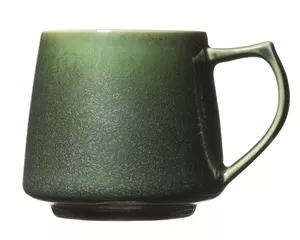
It's all about bringing out the best aroma from the coffee or tea.
Kiki Mugs are made with a careful design process, so you can fully enjoy the distinctive aromas and flavours of specialty coffee.
They have a unique shape, such as a wine glass with a soft texture. When your lips touch the edge of the cup, it is as if you are embraced by its rich aroma and rich flavor.
( KIKI MUG)
Designed to enjoy the aroma that comes out of the cup, a similar experience to wine tasting.
Meticulous craftsmanship
To create the unique pinched shape, multiple moulds are used for each product. This means that the joints need to be smoothed by hand, which makes it take longer and is more involved than in the construction of ordinary mugs.
Wine glass design
The narrow rim ensures that the coffee flows smoothly into the mouth, allowing the aroma to linger and the flavours in each part of the mouth to come into their own.
Unique texture
The prefecture of Gifu is the largest ceramic production area in Japan and Kiki Mugs are made according to the traditional Mino-yakim method. They are porcelain cups, but have a unique smooth and wet texture.
Four traditional Mino-yaki colors are available.
There are different types of Mino-yaki products, with 15 styles certified as Traditional Craft. The four colours of the traditional styles are called "Oribe", "Shino", "Kizeto" and "Setoguro". They are arranged to match modern designs and are all available for purchase
History of Mino-yaki pottery
Mino is located in the south of Gifu prefecture and it is currently the largest producing region of ceramics in Japan. The history is believed to have started when "Sue ware" was introduced from Korea more than 1300 years ago. Mino pottery became famous in Heian period and some potters in Seto region started business in Mino. This was the beginning of so-called "Koseto" era. It then moved into "Seto/Mino" era when they started using the bigger ovens. In Momoyama period, Moni-yaki pottery blossomed with the development of tea ceremony, and some potters in this "Seto/Mino" era started to develop a new style of pottery. This was the golden era in the long history of Mino. During Edo period, the number of ovens in each area became under the strict control with ownership system in place. At the same time, porcelain products came into the market and some regions even developed unique local products. Mino-yaki products became more famous in Meiji period when they got distinguished from Seto-yaki products in the market. Gosuke Kato, Danji Nishiura were some of the celebrated potters at the time and their legacy was passed onto other Mino potters of the modern time such as Toyozo Arakawa, Kagemasa Hayashi, and Keisyu Kato (all holders of Important Intangible Cultural Assets). Other potters who made some influence on the Mino pottery industry are Hajime Kato, Fujio Koyama, andSakuzo Hineno.
These potters, with their skills and attitude, haveset the high standard of Mino-yaki products, and there are more individualistic new products being released at present.
Characteristics
- Height (mm): 85
- Width(mm): 120
- Depth (mm): 90
- Capacity koffie boiler (L): 0,32
- Weight: 0,50 kg
Cores Kiki Mug White (Mino Porcelain)
Reference code: 004896
€17.99
Tax incl.
Product is not in stock



